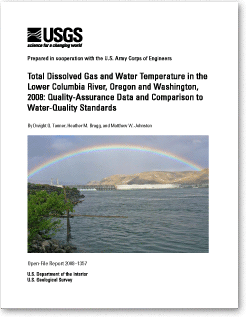 Significant Findings Significant Findings
When water is released through the spillways of dams, air is entrained in the water, increasing the downstream concentration of dissolved gases. Excess dissolved-gas concentrations can have adverse effects on freshwater aquatic life. The U.S. Geological Survey (USGS), in cooperation with the U.S. Army Corps of Engineers, collected dissolved-gas and water-temperature data at eight monitoring stations on the lower Columbia River in Oregon and Washington in 2008. Significant findings from the data include:
- During the spill season of April through August 2008, hourly values of total-dissolved-gas (TDG) concentration were occasionally larger than 115-percent saturation for the forebay stations (John Day navigation lock, The Dalles forebay, Bonneville forebay, and Camas). Hourly values of TDG concentration were occasionally larger than 120-percent saturation for tailwater stations (John Day tailwater, The Dalles tailwater, and Cascade Island).
- From late July to September 2008, water temperatures were greater than 20°C (degrees Celsius) at seven stations on the lower Columbia River. According to the State of Oregon temperature standard, the 7-day average maximum temperature of the lower Columbia River should not exceed 20°C; Washington regulations state that the 1-day maximum should not exceed 20°C as a result of human activities.
- Each of the in situ field checks of TDG sensors with a secondary standard was within ± (plus or minus) 1-percent saturation after 3 to 4 weeks of deployment in the river. All field checks of barometric pressure were within ±2.0 millimeters of mercury of a secondary standard, and water-temperature field checks were all within ±0.2°C.
- For the eight monitoring stations in water year 2008, an average of 99.6 percent of the TDG data were received in real time by the USGS satellite downlink and were within 1-percent saturation of the expected value on the basis of calibration data, replicate quality-control measurements in the river, and comparison to ambient river conditions at adjacent stations. Data received from the individual stations ranged from 98.8 to 100.0 percent complete.
|
Part or all of this report is presented in Portable Document Format (PDF); the latest version of Adobe Reader or similar software is required to view it. Download the latest version of Adobe Reader, free of charge. |